Aegean Lentil Pasta
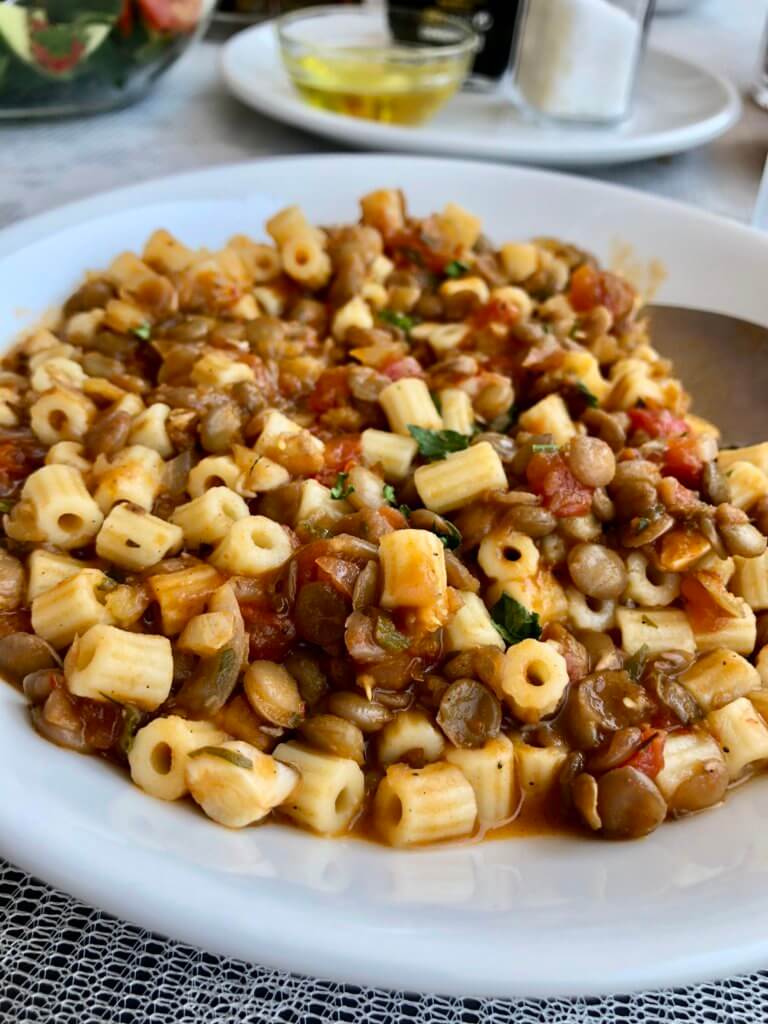
As many of you readers of my blog and followers on social media know already, I’ve been in Turkey for several months exploring the cuisine and the sights of the southern Turquoise Coast. It’s a beautiful place with some majestic scenery and a tradition of down to earth local foods that combine the Aegean with the Mediterranean cultures, as where I am in Fethiye-Mugla is literally the place where both waters meet.
The thing is, that being here has given me an entirely new appreciation for my own Sicilian heritage. The island of Sicily is not far from here- a straight shot west basically- and has a similar, albeit dryer, climate. So it’s no surprise that the ingredients here are quite similar to those I grew up with, showing up in delicious Sicilian recipes centuries old that must have been created out of sheer availability of local and seasonal foodstuffs.
My grandmother used to make a dish called lenticchie, which is basically a soup with lentils and small pasta like ditalini. I wasn’t the biggest fan of it because the lentils always seemed to go mushy all over the pasta and I’m particular about the texture of my pasta, as well as the taste. It takes a lot for me to eat it without real tomato sauce…
Nevertheless, I grew up and reminisced about everything my grandmother made and wanted to try my hand at it all just so that I could be surrounded by the smell of her cooking again.
As such, we all develop our own tastes and techniques for recipes- at least that’s what I always do no matter the origin of the recipe. I don’t stress about making things exactly the way someone else made certain dishes; instead I go upon my own intuition and let the smell and taste of the food guide me towards what I’d be satisfied to eat.
This Aegean Lentil Pasta recipe is just that. Years of formulating my own taste preferences and an appreciation for what’s not just seasonal and local, but what’s available in my own kitchen in an effort not to waste what’s already there. In this case, it was many of the Turkish kitchen basics: onion, garlic, tomato, red pepper paste, lentils, olive oil and key spices like Turkish thyme and ground red pepper.
I think what helps me to get the texture of the lentils just how I like them is to cook them ahead and separate from any of the other ingredients. That way, I keep a watchful eye and boil them just until they get how I like them- cooked, but not mushy. Depending upon how much you’re cooking, in a typical dish that feeds 4 people, this should take about 20 minutes.
Once the lentils are cooked, strain and set aside.
In a medium to large deep pan or deep-bottom sauce pan, warm the olive oil and then add the chopped tomatoes, onions and garlic all at once.
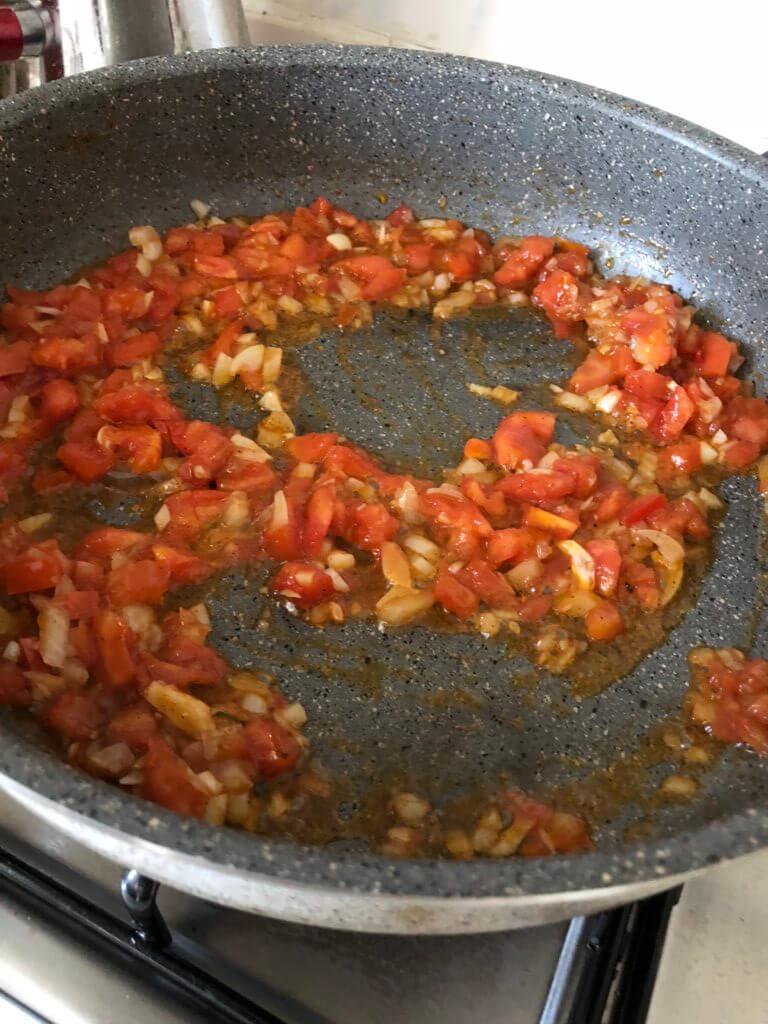 Once the onions have gone translucent, add the thyme, salt, black pepper and ground red pepper. Also add the cooked and strained lentils.
Once the onions have gone translucent, add the thyme, salt, black pepper and ground red pepper. Also add the cooked and strained lentils.
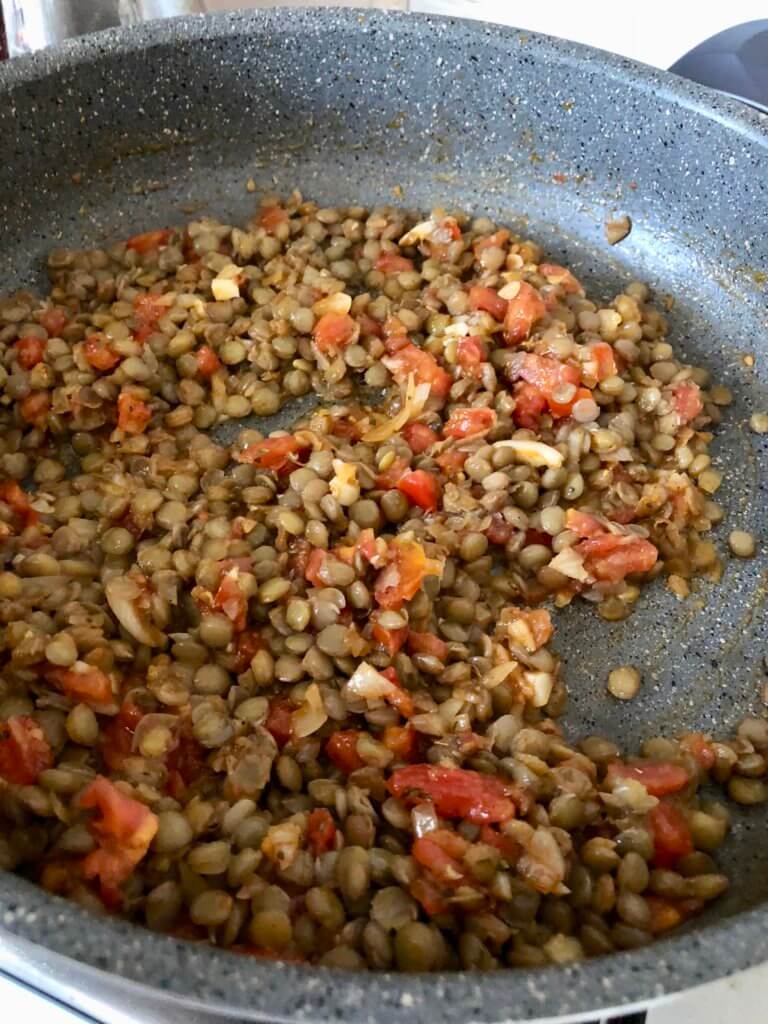 Next comes the addition of water and the red pepper paste, which you should be able to find at Mediterranean markets or even sometimes at World Market. If you’re in a Turkish market (whether in Turkey or abroad, you can find a large jar of the Ipek brand, and it’s called in Turkish “Biber Salçası” (literally, “Pepper Sauce”). This brand also has a halal mark on it, though I am not deeply familiar with it so I can’t say more than that about it or their certification.
Next comes the addition of water and the red pepper paste, which you should be able to find at Mediterranean markets or even sometimes at World Market. If you’re in a Turkish market (whether in Turkey or abroad, you can find a large jar of the Ipek brand, and it’s called in Turkish “Biber Salçası” (literally, “Pepper Sauce”). This brand also has a halal mark on it, though I am not deeply familiar with it so I can’t say more than that about it or their certification.
You need to add the water before the red pepper paste in order to thoroughly whisk or combine the paste into the liquid mixture. It gives it that nice red color and deep, earthy flavor. I’ve only ever been used to using tomato sauce or paste in this recipe before, but the red pepper really has converted me into making it with this flavor profile instead–and it makes it very Aegean, and very Turkish.
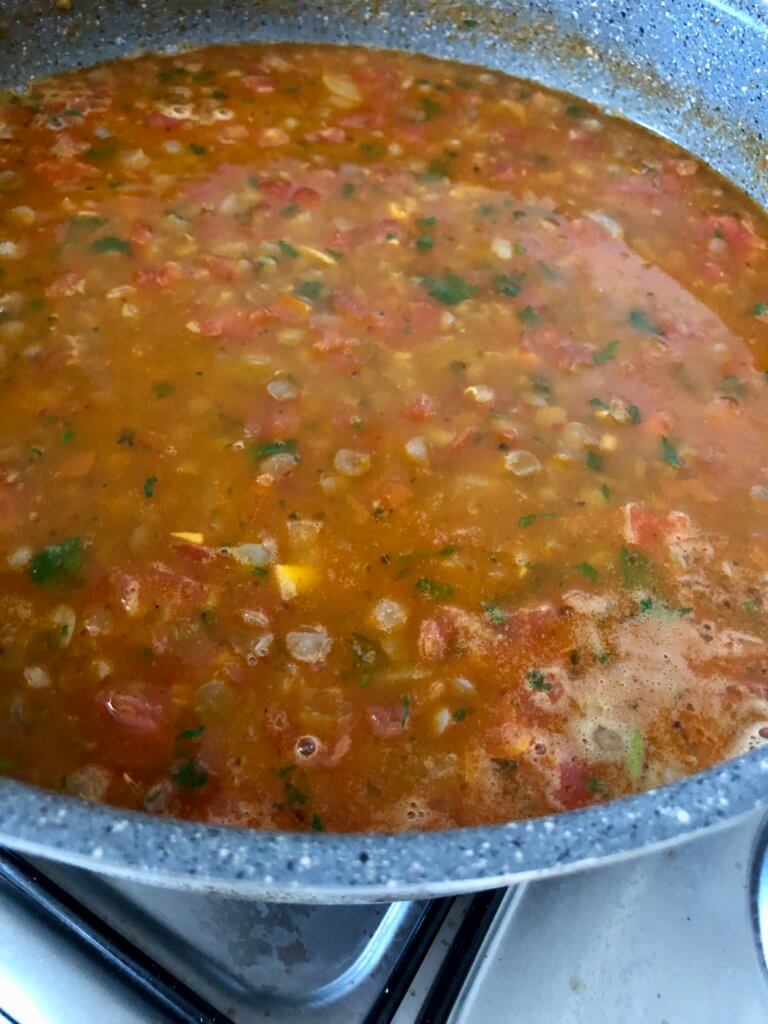 At this stage, I also add some fresh parsley– not too much, because I’ll add it at the end, too, but just some for flavor.
At this stage, I also add some fresh parsley– not too much, because I’ll add it at the end, too, but just some for flavor. 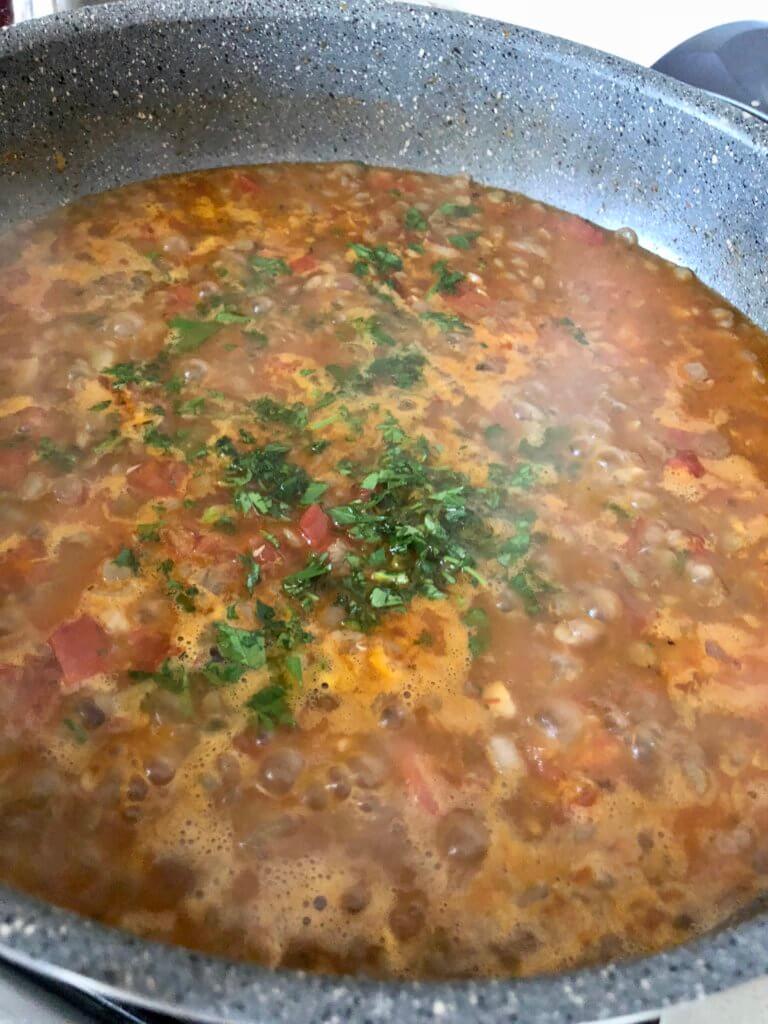 Next, once the water comes to a boil, add the ditalini pasta. Please don’t use large noodles or anything larger than the largest size of ditalini available- it really sort of ruins the proportions of this dish and you probably won’t enjoy eating it. There’s a reason why the small ditalini pasta is used here, and it’s not just tasty, but also pleasurable.
Next, once the water comes to a boil, add the ditalini pasta. Please don’t use large noodles or anything larger than the largest size of ditalini available- it really sort of ruins the proportions of this dish and you probably won’t enjoy eating it. There’s a reason why the small ditalini pasta is used here, and it’s not just tasty, but also pleasurable.
Because the pasta has to cook, you’ll need to cover the pan at this point and let it cook for the customary 10-12 minutes it normally takes to get done. This is not the time for al dente pasta here, please. I don’t use a whole bag or box of pasta, either. I just sprinkle the amount I want- about 1/2 cup or about half the amount or less than the lentils. 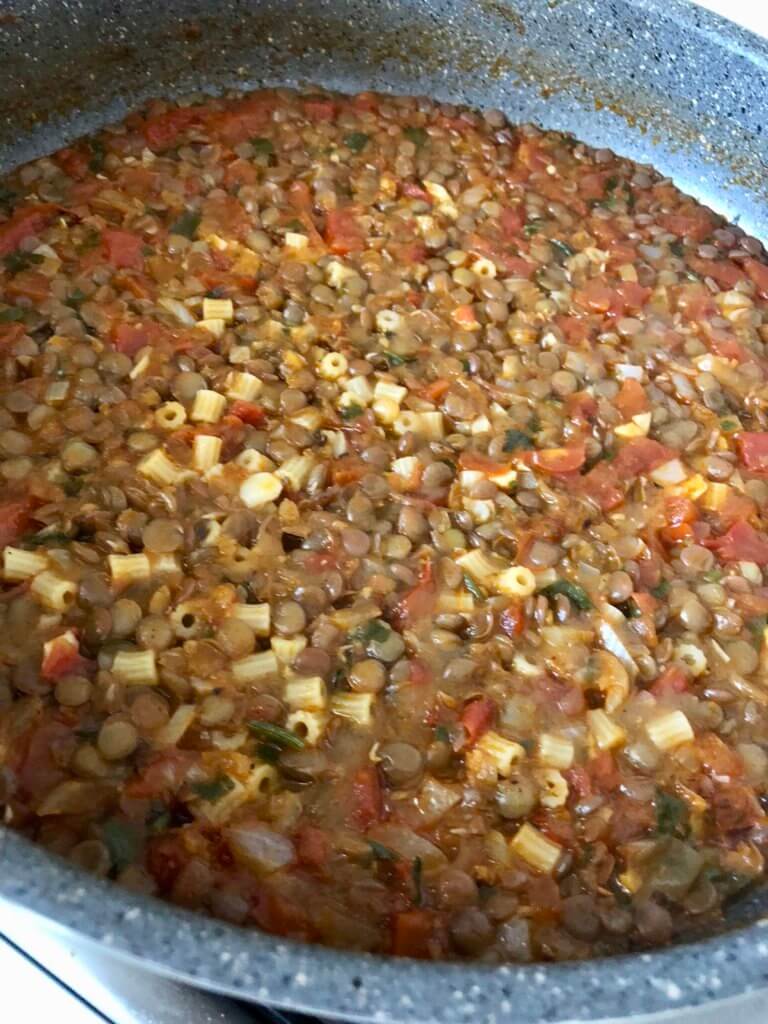 Once the pasta cooks, you may still have a lot of liquid in the pan. At this point, you can either 1) enjoy this dish as a soup (that’s how my grandmother served it); or 2) let most of the liquid cook out until you reach the desired consistency and serve it as a pasta.
Once the pasta cooks, you may still have a lot of liquid in the pan. At this point, you can either 1) enjoy this dish as a soup (that’s how my grandmother served it); or 2) let most of the liquid cook out until you reach the desired consistency and serve it as a pasta.
I chose the latter for a couple of reasons. First, it’s too hot to drink soup right now; and second, I just really loved the way this turned out once most of the liquids evaporated- it was super easy to eat with a spoon. On top, just add a drizzle of olive oil, chopped fresh parsley and if you have a good fresh Parmesan or dried goat cheese, go for it. I didn’t have any cheese, but it’s the one thing I know for sure was missing. Otherwise, it’s a completely vegan meal.
Bismillah & Afiyet Olsun!



- 2 cups lentils, cooked
- 2 tablespoons olive oil
- 1 large tomato, diced
- 1 small onion, diced small
- 4 cloves garlic, crushed and chopped
- 2 teaspoons dried Turkish thyme (kekik). If you cannot find this, just try to source the most pungent dried thyme you can find.
- 2 teaspoons sea salt, or to taste
- 1 1/2 teaspoons ground black pepper
- 2 teaspoons ground red pepper or smoked paprika
- 4-6 cups of water
- 2 heaping tablespoons red pepper paste
- 2 tablespoons freshly chopped parsley
- 3/4 cup ditalini pasta
- drizzle olive oil to top (optional)
- freshly chopped parsley to top (optional)
- freshly grated Parmesan or dried raw milk goat cheese (optional)
- Cook the lentils according to package instructions, to the desired texture you want in this dish. Don't expect them to cook too much with the other ingredients, so make sure they're completely done.
- Once the lentils are cooked, strain and set aside.
- In a medium to large deep pan or deep-bottom sauce pan, warm the olive oil and then add the chopped tomatoes, onions and garlic all at once.
- Once the onions have gone translucent, add the thyme, salt, black pepper and ground red pepper. Also add the cooked and strained lentils.
- Next add the water (start with four cups and go up to six if you prefer more liquid) and the red pepper paste.
- You need to add the water before the red pepper paste in order to thoroughly whisk or combine.
- Add fresh chopped parsley, if desired.
- Once the water comes to a boil, add the ditalini pasta. Cover the pan and let cook for 10-12 minutes. Once the pasta is finished, either add more water to create a soup dish or leave as is.
- When ready to serve, add a drizzle of olive oil, chopped fresh parsley and dried Parmesan or goat cheese.





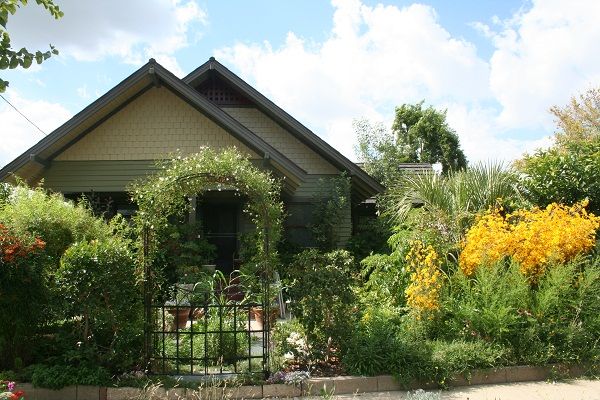


Lentils are incredibly common in Greek cuisine. This dish is one of the many ways you can use them! I like to garnish mine with a little chopped, fresh parsley.